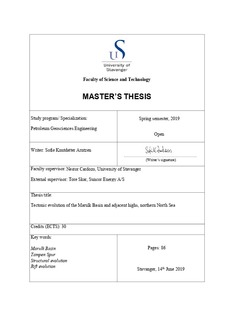| dc.contributor.advisor | Skar, Tore | |
| dc.contributor.advisor | Cardozo, Nestor | |
| dc.contributor.author | Arntzen, Sofie Knutdatter | |
| dc.coverage.spatial | North Sea | nb_NO |
| dc.date.accessioned | 2019-09-30T11:12:56Z | |
| dc.date.available | 2019-09-30T11:12:56Z | |
| dc.date.issued | 2019-06-14 | |
| dc.identifier.uri | http://hdl.handle.net/11250/2619353 | |
| dc.description | Master's thesis in Petroleum Geoscience Engineering | nb_NO |
| dc.description.abstract | The Marulk Basin is located in the northern North Sea, at the boarder towards the Mid-Norwegian Margin. The geological evolution of the Marulk Basin has received limited attention in the literature, and thus, the main motivation of this thesis study is to improve the geological understanding of this marginal area of the northern North Sea. Interpretation of 3D seismic data combined with regional 2D seismic lines and exploration wells are used to assess the tectonic evolution of the Marulk Basin with adjacent highs and put it into a regional context with regards to the northernmost propagation of the North Sea rift system. The northern part of the North Sea rift system (Viking Graben) was affected by two main extensional events; the Permo - Triassic and the middle Jurassic-early Cretaceous event with continued fault activity into the early Cretaceous. Interpretation of geological cross-sections and analysis of thickness maps shows thickness variations of the pre-rift, syn-rift and post-rift successions between the Viking Graben basins and the north-westerly basins. Basin-bounding faults become progressively younger towards the northwest thereby reflecting a northwestward shift in depocenter development from Jurassic to Cretaceous times. The Marulk Basin and the adjacent highs are bounded by large (first-order) normal faults having geometries varying from steeply dipping planar faults to listric and ramp-flat-ramp fault plane geometries. The NNE-SSW first-order faults are interpreted to be of Permo-Triassic origin, while the NE-SW trending faults are more likely to originate from the middle Jurassic-early Cretaceous rift event. The Marulk Basin and adjacent highs are further separated by smaller (second-order) normal faults showing greater variation in trend and origin. Faults related to the Jurassic extensional event are divided into two fault populations that are related to a middle Bathonian-early Oxfordian rift stage and a late Oxfordian-early Cretaceous rift stage. The southern end of the Marulk Basin and the Tampen Spur show a clear multiphase rift evolution, while the central and northern areas area of the Marulk Basin is mostly affected by late Jurassic- early Cretaceous extension. | nb_NO |
| dc.language.iso | eng | nb_NO |
| dc.relation.ispartofseries | Masteroppgave/UIS-TN-IEP/2019; | |
| dc.subject | Marulk Basin | nb_NO |
| dc.subject | petroleumsgeologi | nb_NO |
| dc.subject | petroleum geology | nb_NO |
| dc.subject | northern North Sea | nb_NO |
| dc.title | Tectonic evolution of the Marulk Basin and adjacent highs, northern North Sea | nb_NO |
| dc.type | Master thesis | nb_NO |
| dc.description.version | submittedVersion | nb_NO |
| dc.subject.nsi | VDP::Mathematics and natural science: 400::Geosciences: 450::Petroleum geology and petroleum geophysics: 464 | nb_NO |
| dc.subject.nsi | VDP::Technology: 500::Rock and petroleum disciplines: 510::Geological engineering: 513 | nb_NO |
